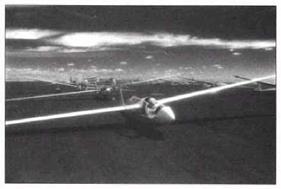Wheels Can Be a Drag
Of the different types of drag, parasite drag (see Chapter 8) takes the most massive toll on fixed-wing flyers. A glider’s lack of power makes it even more important to reduce parasite drag as much as possible.
In a conventional small airplane, one of the biggest culprits in producing parasite drag is the landing gear. Landing gear is needed only twice during flight, during takeoff and landing, but it sticks out in the wind for the duration of the flight anyway. And planes that are designed to retract the gear during flight pay a penalty in the extra weight and complexity of all the hydraulics and motors that make the gear move up and down.
A glider can afford neither of these luxuries, so glider designers usually equip their craft with only a single wheel, right below the cockpit. They shelter the wheel as much as possible inside the smooth, aerodynamically clean fuselage. The small curve of the wheel that peeps out of its well has a lot smaller effect on parasite drag than the three wheels and wheel struts that are typical on conventional airplanes. And it certainly weighs less than a lot of hydraulics and motors.
Nevertheless, in some high-performance gliders, the wheel is retractable, just like the gear on high-performance airplanes and jetliners. The single wheel can be pulled up into the body of the glider during flight with a simple lightweight mechanism to cut down even further on parasite drag; the wheel can be lowered just before landing.
Taking Off
Glider pilots can orchestrate their takeoffs in a couple of ways. The most common method is the tow plane, a conventional powered airplane that uses a rope to drag a
|
|
|
By the Book Glider pilob typically prefer to fly from their own airports, which they call glider ports, or sailporb. The reason is that by FAA regulation, gliders have the right of way over powered aircraft in approaching the airport—after all, an unpowered glider only has one chance to get the landing right Gliders can easily disrupt the flow of airplanes in and out of many airports; glider-only airports arc less intrusive. |
At some glider airports, or (IT+)sailports,(IT) a car is used to do the same thing. A driver races the car down the runway with the glider in tow. The glider lifts off behind the accelerating car, and when it’s high enough, the pilot pulls a knob to release the tow rope. The glider flies away, and the car returns to its start point to tow the next glider.
At some glider airports a stationary winch is used to tug the glider into the sky. A rope is unspooled from the winch and attached to the glider. On a signal from the pilot, the winch is engaged, and the motorized spool reels in the rope with enough speed that the glider is able to develop enough lift to take off. At the right altitude, the pilot pulls a release knob inside the cockpit to disconnect from the rope.
|
|
|
|
Contestants prepare their sailplanes for a day of competition in a National Sports Class Contest sponsored by the Seattle Glider Council. The contest was held at the Ephrata, Washington, airport.
(Vince Miller)













